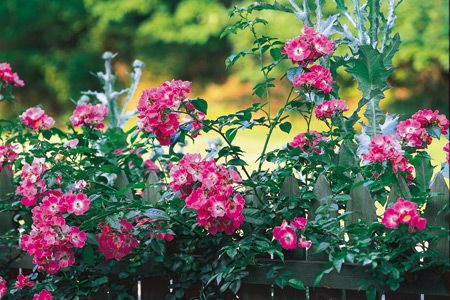We may be compensated if you purchase through links on our website. Our team is committed to delivering honest, objective, and independent reviews on home products and services.

Climbing roses add a touch of romance and elegance to any garden, transforming ordinary structures into breathtaking vertical displays. These versatile plants can adorn fences, trellises, arbors, and even the sides of buildings with cascades of colorful blooms. Whether you’re a seasoned gardener or a novice, understanding how to choose, plant, and care for climbing roses will help you create a stunning landscape that blooms season after season.
About Climbing Roses
Climbing roses are not true vines but rather shrubs with long, flexible canes that you can train to grow upward. These roses come in various types and growth habits, each offering unique features to suit different garden styles and preferences.
Types of Climbing Roses
There are two primary types of climbing roses—climbers and ramblers. Climbers typically grow 8–10 feet tall and bloom repeatedly throughout the growing season. They’re ideal for most garden structures and offer a more controlled growth habit. Ramblers, on the other hand, can reach heights of 15–25 feet and usually bloom once a year in a spectacular display.
Differences Between Climbers and Ramblers
While both types can create stunning vertical displays, climbers and ramblers have distinct differences. Climbers are more compact and manageable, making them suitable for smaller spaces and structures. They also tend to have larger flowers and bloom multiple times. Ramblers are more vigorous, with smaller flowers in larger clusters, and are better suited for covering large areas or tall structures.
Case Study: Climbing Roses at Their Best
Rosarian Mike Lowe sells everything from hybrid shrubs to old English varieties at his Nashua, New Hampshire nursery Lowe’s Roses. Take a tour of his own 2-acre property, though, and it becomes clear that he favors roses with a climbing habit. The landscape is divided into half a dozen “garden rooms,” formed by the placement of stone walls, wood fences, arbors, and a greenhouse, most of which cascade with blooming roses each spring.
These vinelike roses give the space a colorful and natural appearance, as if even the architectural features had grown up from the ground. “I get changing views through the seasons—bare canes and red hips against granite or wood in fall, dark green foliage when the blooms have past, and, of course, the profusion of bright red, pink, yellow, and white flowers when they’re at their peak,” says the 40-year veteran of rose growing.

Selecting the Right Climbing Rose for Your Space
Choosing the perfect climbing rose involves considering your climate, available space, and desired bloom features. Taking these factors into account will allow your roses to thrive and provide the visual impact you’re looking for.
Climate Considerations
Roses have specific climate requirements, and not all varieties will thrive in every region. Larry Parton, a rose grower for 25 years and owner of the Northland Rosarium in Spokane, Washington, advises, “A lot of roses that grow fine in the Southeast won’t make it in the Southwest.” To find the best varieties for your area, consult local rose nurseries or rose societies.
Growth Habits and Mature Size
Match the mature size of the rose you chose to the structure you want it to cover. Some modern climbers grow only 6–7 feet tall, which is perfect for fences and lampposts but may not reach the top of a tall arbor or pergola. Consider the space you have and pick a variety that will fill it appropriately without getting overgrown.
Bloom Characteristics and Fragrance
Consider the color, flower type, fragrance, and bloom duration when selecting your climbing rose. Some varieties offer continuous blooming throughout the season, while others provide a spectacular but brief show. Think about how the rose’s characteristics will complement your existing garden design and personal preferences.

Preparing Your Garden for Climbing Roses
Proper preparations help your climbing roses thrive in their new home. This includes selecting the right location, creating a strong support system, and preparing the soil for planting.
Choosing the Ideal Location
Roses need ample sunlight to bloom properly. Parton emphasizes, “They need sunlight to bloom. That means at least six to eight hours of sun on a clear day. This is an almost absolute rule—roses don’t flower in shade.” Choose a location that receives plenty of direct sunlight and has good air circulation to prevent disease.
Creating a Support System
Climbing roses need a support structure to grow on, as they don’t cling well to surfaces on their own. Trellises, arbors, fences, and even walls with proper supports can work well. When you attach roses to their support, use flexible materials like plastic garden tape or soft twine. Parton warns, “Don’t use wire. It can bite into rose canes and kill them.”
Companion Plants for Climbing Roses
Pair your climbing roses with complementary plants to create a more diverse and visually interesting garden. Clematis, lavender, and catmint are excellent companions that can enhance the beauty of your roses while attracting beneficial pollinators.
Creative Landscaping Ideas
Use climbing roses to soften harsh architectural lines, create privacy screens, or frame garden entrances. You can also train them to grow horizontally along fences or walls, creating a stunning floral hedge. Experiment with different training techniques to get a unique and personalized garden design.

Grafted vs. Ungrafted Climbing Roses
When selecting climbing roses, you’ll encounter both grafted and ungrafted varieties.
Pros and Cons of Each Type
Grafted roses combine the desired variety with a hardy rootstock, often resulting in faster growth and earlier blooming in the first year. However, they can produce suckers from the rootstock, which may overtake the desired variety if you don’t properly manage them. Ungrafted roses, also known as own-root roses, grow more slowly initially but are often hardier in the long run and don’t produce suckers.
How To Choose Between Grafted and Ungrafted
Both Lowe and Parton recommend buying ungrafted roses when possible. Lowe explains, “They never send out suckers.” If you do opt for grafted roses, Lowe advises, “Be sure to get a grade 1 or 1 1⁄2 plant. ” These grades indicate the number and quality of canes, with grade 1 being the best.
Our Conclusion
Climbing roses offer a unique combination of beauty and versatility to any garden. By carefully selecting the right variety for your home, providing proper support and care, and getting creative with your styling, you can make a stunning vertical display of climbing roses.

